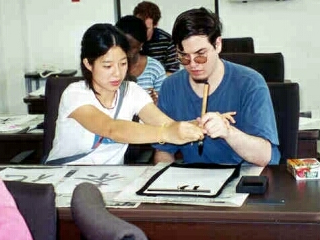Lesson 2
Japanese Writning Systems
In this lesson, we will introduce the Japanese writing system. There are three character sets in Japanese. These are hiragana, katakana, and kanji. Kanji characters were adopted from China, and hiragana and katakana were subsequently developed in Japan. HIragana was developed by simplifying some kanji characters while katakana was developed by taking parts of some kanji characters. Both hiragana and katakana characters are phonetic symbols. That is, each character represents sounds. In contrast, kanji characters are idiographic symbols with pictorial qualities. Each kanji character represents idea(s). Technically, it is possible to write Japanese using only phonetic-based hiragana and katakana. Many children's books are writen this way. However, in normal writing, we use all three writing character sets simultaneously --- kanji for most content words, katakana for foreign words, onomatopoeias and some proper nouns (e.g., company names like Sony and Panasonic), and hiragana for the rest (e.g., function words such as particles, suffixes, and some content words, etc.). This is shown below.
In this lesson, we will focus on how to read and write hiragana and katakana. Kanji will be introduced later. When you practice. make sure that you use a pencil or mechanical pencil and copy the shape of each character slowly at first. If you do so, you may develop a nice handwriting in Japanese. There are fixed stroke order and directions for each character, and the order and the directions may not be what you expect them to be. Copy the model as closely as possible and don't try to be too inventive here. To memorize efficiently, always pronounce every character. If you feel that you are not making reasonable progress, please contact your teacher and ask for advice. Japanese can also be transcribed entirely in romaji (Roman alphabet). Unfortunately, the use of romaji is limited in Japan. (Only some public signs in train stations and airports are written in romaji.) One place where romaji is useful is when you type Japanese into a computer by using the English keyboard. We will also learn how to do this in this lesson. |
||||||
Also the following gramamr structures will be introduced.
|
||||||

